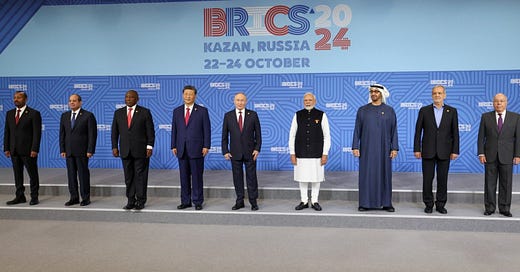Building BRICS to Demolish the Dollar Monopoly?
Is the Proposed BRICS Payment System the Beginning of the End of the US Dollar's Status as the Default Currency of the World?
Conception and Concept of BRICS Digital Currency
The BRICS bloc, now 10 nations strong, recently convened at Kazan, Russia, under the leadership of Russian President Vladimir Putin, marking a significant diplomatic manoeuvre in challenging the global financial status quo. During the summit, India’s Prime Minister Narendra Modi emphasised that BRICS is not an anti-Western alliance but a non-Western intergovernmental organisation committed to rebalancing global governance. The conception of the BRICS payment system by Brazil, Russia, India, China, South Africa, and new members has raised important questions about the future of global financial systems.
The US dollar, which has long enjoyed dominance as the world’s reserve currency, facilitating trade and stabilising economies, now faces a potential rival. The BRICS nations are building a financial infrastructure to reduce their reliance on the dollar for international transactions. The creation of the BRICS Pay system, a blockchain-based platform that supports payments in local currencies, illustrates the evolving concept of a multipolar financial world. But does this represent the beginning of the end for the dollar's hegemony, or are we witnessing the conception of a parallel payment system that will coexist alongside the dollar?
The Rise of BRICS Pay: Features and Advantages
BRICS Pay is a digital payment system developed to streamline cross-border transactions between BRICS nations by allowing payments in local currencies rather than relying on the US dollar alone. Built on Distributed Ledger Technology (DLT), the system is secure, transparent, and efficient, offering an alternative to traditional financial networks like SWIFT. With the integration of Central Bank Digital Currencies (CBDCs) and smart contracts, BRICS Pay aims to reduce the cost of international transfers, eliminate the need for currency conversion, and offer a faster alternative to the often-cumbersome SWIFT system.
One of the key features of BRICS Pay is its potential to promote financial inclusion. By offering digital payment solutions, even underbanked populations in BRICS countries could benefit from secure, real-time financial transactions. The system is also expected to be adopted by over 150 countries, creating a massive network of economies outside the traditional Western financial fold. This mass adoption could enable the BRICS countries to conduct trade in their local currencies, further weakening the dollar’s hold on international trade.
India's Digital Currency Initiative
An important aspect of BRICS' broader financial strategy is India’s own development of its Central Bank Digital Currency (CBDC), the Digital Rupee. India has been testing the Digital Rupee in both retail and wholesale sectors, with over 4 million merchants and 4.3 million retail users involved in its ongoing pilot phase. The Digital Rupee is designed for everyday transactions and leverages blockchain technology for secure and transparent dealings. The system even supports offline transactions, a critical feature for areas with limited internet access.
The RBI's initiative aligns with the BRICS goal of de-dollarization by providing a stable digital alternative for cross-border transactions. India’s push towards CBDCs could accelerate the integration of national currencies within the BRICS Pay system, allowing seamless cross-border payments while reducing the dependence on the US dollar for international trade.
De-dollarization: Will BRICS Pay Challenge the Dollar’s Dominance?
De-dollarization, or the move to reduce reliance on the US dollar in global trade, is a key goal behind the creation of BRICS Pay. BRICS nations have been increasingly seeking economic independence from Western financial systems, especially as several of these countries, like Russia and China, have faced US sanctions. The use of local currencies for international trade will enable BRICS nations to avoid such sanctions while asserting greater control over their economies.
The impact of de-dollarization, however, extends beyond politics. The US dollar’s role as the world’s reserve currency means it is used in the majority of international trade and financial transactions. A shift away from the dollar would likely decrease global demand for the currency, reducing its value and, by extension, the leverage the US holds in international financial markets. This is a direct challenge to the Bretton Woods system, which placed the dollar at the heart of global trade following World War II.
Technological Advantage: Blockchain and Digital Currencies
The BRICS payment system utilises blockchain technology to ensure security, transparency, and decentralisation. Unlike traditional systems, where financial intermediaries are involved, blockchain allows for real-time settlement of transactions, significantly reducing the costs and time associated with international transfers. The potential for smart contracts—self-executing contracts with the terms written directly into code—further enhances its appeal by automating and securing payments.
Additionally, the BRICS nations are developing Central Bank Digital Currencies (CBDCs), which will play a crucial role in this payment system. Digital currencies, backed by central banks, are likely to be integrated into BRICS Pay, further increasing its resilience against traditional currencies like the US dollar. This could also signal a shift towards a future where national digital currencies compete on an international scale, enabling countries to bypass dollar-based systems entirely.
Challenges Facing BRICS Pay
While BRICS Pay presents a significant threat to dollar dominance, its success is not guaranteed. The US dollar remains deeply entrenched in the global economy. It accounts for the majority of global currency reserves and is widely accepted in international trade, especially for commodities such as oil and gold. The liquidity and stability of the US dollar make it an attractive option for central banks and governments alike.
The infrastructure of the global financial system is also largely based on the dollar, making it difficult for any new currency or system to gain widespread acceptance. Additionally, while the BRICS countries represent a significant portion of the world’s population and GDP, their economies vary in strength, political stability, and governance. India and China, for instance, are geopolitical rivals, which may complicate cooperation on financial matters. Furthermore, the system will require significant trust from the international community, as any payment system requires global buy-in to succeed on the scale BRICS Pay envisions.
Lessons from History: The Euro’s Challenge to the Dollar
The introduction of the Euro in 1999 was widely viewed as a potential rival to the dollar. The Eurozone brought together some of the world’s largest economies under a common currency, and there were widespread expectations that the euro would eventually replace the dollar as the world’s leading reserve currency. Despite this, the dollar retained its dominant position, largely due to the flexibility of the US economy, the deep liquidity of the dollar, and the trust that global markets have in the US financial system.
Similarly, the BRICS Pay system may face an uphill battle in dethroning the dollar. While it offers many advantages, particularly in its use of cutting-edge technology and digital currencies, the dollar’s resilience cannot be underestimated. The depth of US financial markets and the global trust in the dollar as a store of value are formidable barriers that any rival currency must overcome.
Non-dollar Transactions: A Growing Trend
India and Russia have been exploring trade settlements in Indian rupees, particularly for oil imports, as part of a broader strategy to reduce reliance on the US dollar. India has initiated the settlement of some oil imports from Russia in Indian rupees, aiming to promote its currency as a trade settlement tool. This strategy not only reduces the transaction costs associated with currency conversion but also allows India to diversify its oil suppliers and pursue more cost-effective trade practices.
India's collaboration with the UAE has also gained momentum, with both nations formalising an agreement to settle trade in rupees, including payments for crude oil. This development is a significant step towards the internationalisation of the rupee and is part of the broader Comprehensive Economic Partnership Agreement (CEPA) between the two countries, which seeks to reduce transaction costs and deepen economic integration.
In another significant non-dollar arrangement, China and Iran continue to maintain robust trade ties despite US sanctions. China remains Iran's largest trade partner, importing significant amounts of Iranian oil through private channels that bypass traditional financial systems. This strategic partnership allows both countries to circumvent restrictions imposed by dollar-based transactions and continue their long-standing economic relationship.
These examples demonstrate that non-dollar trade practices are increasingly being pursued by countries like India, Russia, UAE, and China, driven by the desire to reduce dependency on the US dollar. However, while these initiatives are growing, they still represent a small fraction of global trade, which remains dominated by dollar transactions.
The Future: Competing Systems, Not the Demise of the Dollar
As we move into the next decade, it is likely that we will see the development of two competing systems of international payments rather than the outright demise of the dollar. The dollar will likely remain the dominant currency, especially in Western nations and among US allies. However, the BRICS Pay system could establish itself as a parallel system, particularly among emerging markets and countries looking to diversify their trade away from the dollar.
This scenario would create a world where international trade is split between two major financial systems, with the US dollar continuing to be a major player, but no longer the only option. For countries within the BRICS sphere of influence, BRICS Pay will offer a viable alternative, reducing their dependency on the US and giving them greater control over their economies. For the US, this means that while the dollar may not be dethroned, it will face a future where it is no longer unchallenged.
Looking Forward
The rise of BRICS Pay marks a significant shift in the global financial landscape. While it may not spell the end of the US dollar’s dominance, it is undoubtedly a step towards a more multipolar world, where different systems compete for influence. The dollar has proven its resilience in the face of past challenges, such as the euro, and is likely to remain the dominant currency for the foreseeable future. However, as BRICS nations continue to grow in economic power and technological capability, a future with two competing payment systems seems increasingly likely. This is not the demise of the dollar, but rather the beginning of a new era in global finance.
Citations:
[1] BRICS Pay to Challenge US Dollar's Dominance
[2] BRICS Pay Explained: How It Works
[3] BRICS Pay and Global Finance
[4] Potential Impact on the Dollar
[5] India's Digital Rupee Initiative






Thanks for this sensible article. As the world is transitioning from unipolar to multipolar, emergence of other currencies to challenge the dominance of erstwhile unchallenged world power is imperative. BRICS will work as a platform allowing everybody to come and trade, according to capacity and appetite. I think, the purpose of BRICS is to decouple the world from dollar dominance, where countries whom US doesn't like (hate/love relationship) can trade without increasing costs.
Having countries like UAE in BRICS (also to large extent India too) will mean that channels of trade between BRICS and Western world will be through these countries who will work as clearing houses between BRICS and Dollar.